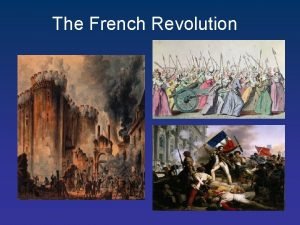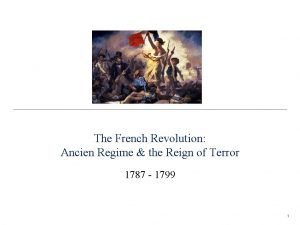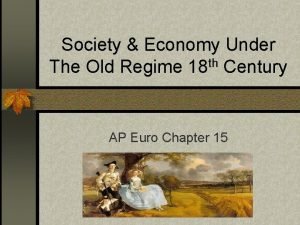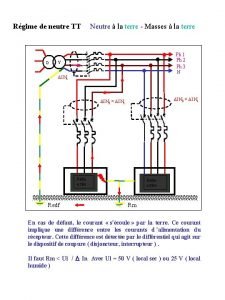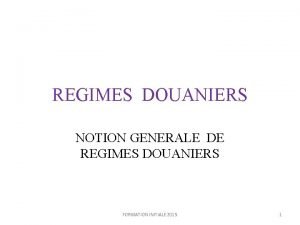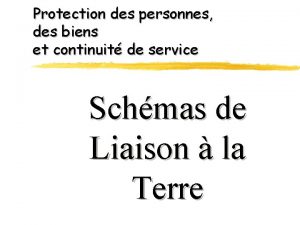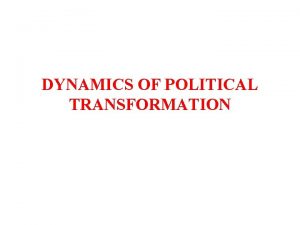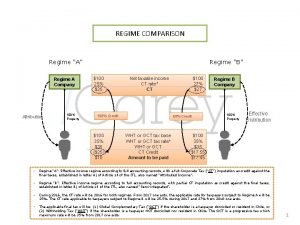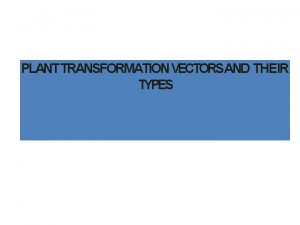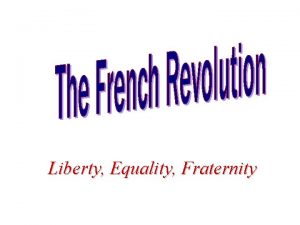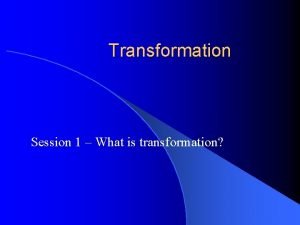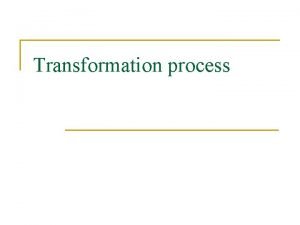DYNAMICS OF POLITICAL TRANSFORMATION TYPES OF POLITICAL REGIME



![CHANGE OVER TIME [cont. ] • The Revolutionary Path (1950 s-1980 s) – “plantation CHANGE OVER TIME [cont. ] • The Revolutionary Path (1950 s-1980 s) – “plantation](https://slidetodoc.com/presentation_image/87cd8d1815f3ff779925f49608a47946/image-4.jpg)





- Slides: 9

DYNAMICS OF POLITICAL TRANSFORMATION

TYPES OF POLITICAL REGIME • Democracy – Oligarchic – Co-optative – Liberal (elections with citizen rights) – Illiberal (elections w/o citizen rights) • Authoritarianism – Traditional (“man on horseback”) – One-party rule – Bureaucratic (B-A regimes) – Revolutionary

CHANGE OVER TIME • Oligarchic Rule and Top-down Reform (1880 s-1920 s) – Military strongmen – “Oligarchic democracy” – Co-optative democracy • Populism and Dictatorship (1930 s-1970 s) – Co-optative democracy – Populist alliances/corporatist states – Women and politics – A democratic surge [1940 s-70 s] – Bureaucratic-authoritarian regimes
![CHANGE OVER TIME cont The Revolutionary Path 1950 s1980 s plantation CHANGE OVER TIME [cont. ] • The Revolutionary Path (1950 s-1980 s) – “plantation](https://slidetodoc.com/presentation_image/87cd8d1815f3ff779925f49608a47946/image-4.jpg)
CHANGE OVER TIME [cont. ] • The Revolutionary Path (1950 s-1980 s) – “plantation societies” – Cuba, Nicaragua—and others? • A Renewal of Democracies (1980 s-present) – – “unsolvable problems” pressure from below ending of Cold War absence of ideology • Rise of the “new left”? (1998 -present) – Politics of protest/use of ballot box – Chávez v. Lula – prospects?

SOCIAL STRUCTURE • Upper Class: – Urban (industrialists, bankers) – Rural (landowners) • Middle Class: – Urban (merchants, lawyers, etc. ) – Rural (small farmers) • Popular/Lower Class: – Urban (workers) – Rural (peasants, campesinos) • National Institutions: – State (including military) – Church • External Sector: – Economic (investors, merchants) – Political (foreign governments)

KEY QUESTIONS • What social groups are present? Or missing? • What kinds of coalitions are in play? On what basis? • What are the lines of social conflict? Vertical or horizontal? Social class or race/ethnicity? • Who has political power? How inclusive is the system? Who is denied access?

COMPARING CASES (i) • Mexico: Revolution of 1910 + dominant-party system • Central America and Caribbean: plantation society, U. S. influence, dictatorship and protest • Cuba: plantation society, socialist revolution, resistance to United States • Question A: Compare Mexican and Cuban revolutions • Question B: Trace colonial legacies in Mexico and Cuba • Question C: Why not more revolution ferment in CA + Caribbean? Given strong resemblance to Cuba?

COMPARING CASES (ii) • Argentina – No peasantry (!) – Alliance: landowners + foreigners + state = oligarchic democracy (1880 s-1916), co-optative democracy (1916 -30) – Working class + industrialists = multi-class populist coalition, Peronist regime (1930 s-1950 s) – Class conflict, repression and bureaucratic-authoritarian regime (1960 s-1980 s) – Resumption of democracy (1983 -present)

COMPARING CASES (iii) • Chile – Peasantry (plus rural proletariat) – Upper class: agriculture + finance/industry + mining, allied with foreign investors (1890 s-1950 s) – Radical politics and horizontal class alliances: workers + peasants vs. landed + industry (1930 s-60 s) – Salvador Allende government (1970 -73) – Volatility in middle-class support (1960 s-70 s) – Bureaucratic-authoritarian regime (1973 -1989) – Restoration of democracy 1990

